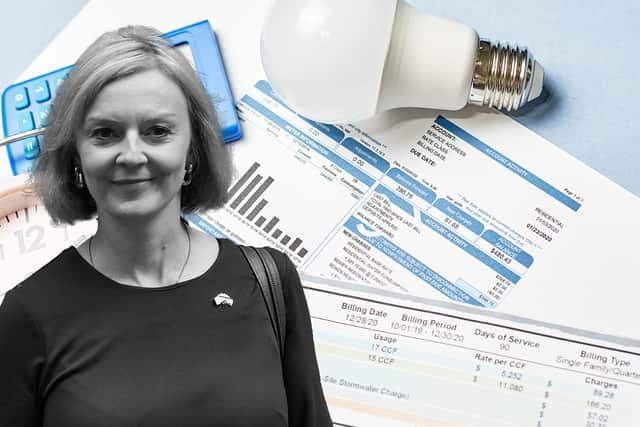Energy Price Guarantee: exact amount households will pay in energy bills from October based on house type
and live on Freeview channel 276
Households on the Ofgem energy price cap will see bills frozen from October under the Prime Minister’s new policy.
Liz Truss announced last week that the typical household energy bill will be capped at £2,500 per year from 1 October for the next two years.
Advertisement
Hide AdAdvertisement
Hide AdIt means that a planned October price cap rise which was expected to see average annual energy bills hit £3,549 has been avoided.
The policy will see the government limit the price energy suppliers can charge customers for units of gas, replacing the existing price cap set by regulator Ofgem. Ministers will then provide suppliers with the difference between the new, lower price and what they would charge were this not in place.
The government has now confirmed exactly how much households will pay for energy from October under the Energy Price Guarantee, based on the type of home.


How much will households pay for energy?
The government has said a typical house will save £1,000 on average when the policy takes effect in October, while the typical flat will save £700.
Advertisement
Hide AdAdvertisement
Hide AdListed is a breakdown of average costs for various property types, outlining the savings made under the Energy Price Guarantee.
Detached houses
A typical detached house will pay £3,300 in gas and electricity bills per year from 1 October.
Under the October price cap, households would have had to pay £4,700 annually. This means the average detached household will make a saving of £1,400 under the government guarantee.
Semi-detached houses
A typical detached house will pay £2,650 in gas and electricity bills per year from 1 October.
Advertisement
Hide AdAdvertisement
Hide AdUnder the October price cap, households would have had to pay £3,800 annually. This means the average semi-detached household will make a saving of £1,150 under the government guarantee.
End-terraced
A typical end-terraced house will pay £2,450 in gas and electricity bills per year from 1 October.
Under the October price cap, households would have had to pay £3,500 annually.
This means the average end-terraced household will make a saving of £1,050 under the government guarantee.
Mid-terraced
Advertisement
Hide AdAdvertisement
Hide AdA typical mid-terraced house will pay £2,350 in gas and electricity bills per year from 1 October.
Under the October price cap, households would have had to pay £3,300 annually.
This means the average mid-terraced household will make a saving of £950 under the government guarantee.
Bungalow
A typical bungalow will pay £2,450 in gas and electricity bills per year from 1 October.
Advertisement
Hide AdAdvertisement
Hide AdUnder the October price cap, households would have had to pay £3,500 annually.
This means the average bungalow will make a saving of £1,050 under the government guarantee.
Converted flat
A typical converted flat will pay £1,950 in gas and electricity bills per year from 1 October.
Under the October price cap, households would have had to pay £2,750 annually.
Advertisement
Hide AdAdvertisement
Hide AdThis means the average converted flat will make a saving of £800 under the government guarantee.
Purpose built flat
A typical purpose built flat will pay £1,750 in gas and electricity bills per year from 1 October.
Under the October price cap, households would have had to pay £2,400 annually.
This means the average purpose built flat will make a saving of £650 under the government guarantee.
Advertisement
Hide AdAdvertisement
Hide AdThe guarantee limits the amount households can be charged per unit of gas or electricity, meaning the exact amount of your bill will be influenced by how much energy you use.
Households do not need to apply for the Energy Price Guarantee and do not need to contact their energy supplier.
Consumers in England, Scotland and Wales who pay for their energy through a monthly, quarterly or other regular bill, will see the Energy Price Guarantee applied when bills are calculated.
Due to the different energy system in Northern Ireland, the government is working with partners, including the NI Utility Regulator and NI energy suppliers, to ensure that an equitable level of support can be delivered to consumers and businesses in Northern Ireland.
Will the energy bills freeze still go ahead despite the Queen’s mourning period?
Advertisement
Hide AdAdvertisement
Hide AdDowning Street has assured it does not believe the mourning period for the Queen’s death will have any impact on Ms Truss’s new policy to prevent average energy bills soaring past £2,500.
The Prime Minister’s official spokesman said on Friday that the two-year energy price guarantee for Britain will be ready for households from 1 October as scheduled.
Officials are working in the background to draw up a strategy to support businesses through the gas crisis for six months and come up with a plan for Northern Ireland, as part of the multibillion-pound package.
Chancellor Kwasi Kwarteng will also need to find a date to reveal his emergency financial package, as politics as normal pauses for around 10 days, while the House of Commons will be suspended.
Comment Guidelines
National World encourages reader discussion on our stories. User feedback, insights and back-and-forth exchanges add a rich layer of context to reporting. Please review our Community Guidelines before commenting.
